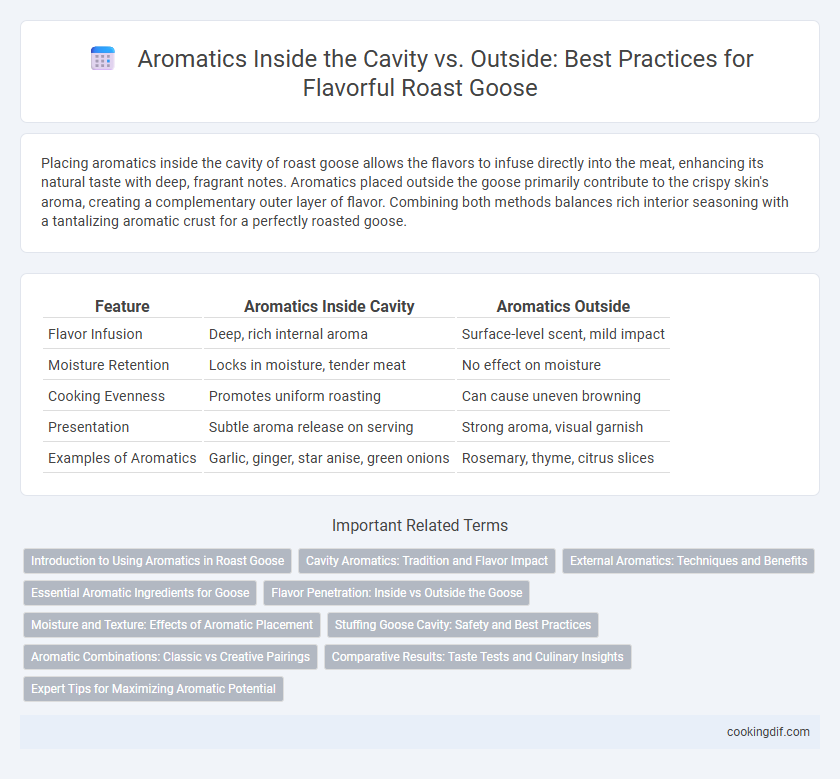Placing aromatics inside the cavity of roast goose allows the flavors to infuse directly into the meat, enhancing its natural taste with deep, fragrant notes. Aromatics placed outside the goose primarily contribute to the crispy skin's aroma, creating a complementary outer layer of flavor. Combining both methods balances rich interior seasoning with a tantalizing aromatic crust for a perfectly roasted goose.
Table of Comparison
| Feature | Aromatics Inside Cavity | Aromatics Outside |
|---|---|---|
| Flavor Infusion | Deep, rich internal aroma | Surface-level scent, mild impact |
| Moisture Retention | Locks in moisture, tender meat | No effect on moisture |
| Cooking Evenness | Promotes uniform roasting | Can cause uneven browning |
| Presentation | Subtle aroma release on serving | Strong aroma, visual garnish |
| Examples of Aromatics | Garlic, ginger, star anise, green onions | Rosemary, thyme, citrus slices |
Introduction to Using Aromatics in Roast Goose
In roast goose, placing aromatics inside the cavity enhances the infusion of flavors directly into the meat, resulting in a more pronounced and juicy taste. Common cavity aromatics include garlic, ginger, star anise, and citrus, which break down during roasting to release essential oils and moisture. Applying aromatics outside the goose primarily imparts surface aroma and contributes to crispy skin but is less effective for deep flavor penetration compared to cavity stuffing.
Cavity Aromatics: Tradition and Flavor Impact
Cavity aromatics such as fresh herbs, garlic, and citrus slices infuse roast goose with deep, evenly distributed flavors that penetrate the meat from the inside, enhancing moisture and tenderness. Placing aromatics inside the cavity allows the goose to self-baste during roasting, preserving juiciness and creating a richly layered taste profile. This traditional technique elevates the natural gamey flavor of goose while imparting subtle herbal and citrus notes that complement its robust texture.
External Aromatics: Techniques and Benefits
Applying external aromatics to roast goose enhances the skin's flavor profile through direct heat infusion, enabling browning and crisping with infused herbs like rosemary, thyme, and garlic. Techniques such as rubbing or basting the goose with aromatic mixtures and citrus zest create a fragrant crust that complements the rich meat inside. This method improves aroma release, intensifies flavor depth, and delivers an appealing visual texture that highlights the roast's succulence.
Essential Aromatic Ingredients for Goose
Essential aromatic ingredients for roast goose include star anise, cinnamon sticks, and cloves, which are often placed inside the cavity to infuse the meat with deep, fragrant flavors during roasting. Fresh garlic, ginger, and scallions can be added both inside and outside the goose to enhance the aroma and tenderize the meat. Using a combination of these aromatics inside the cavity creates a concentrated infusion, while rubbing the exterior with herbs like rosemary or thyme accentuates the skin's crispy texture and overall flavor complexity.
Flavor Penetration: Inside vs Outside the Goose
Aromatics placed inside the cavity of a roast goose infuse the meat more deeply, allowing herbs and spices to penetrate the flesh and enhance flavor from within. When aromatics are applied outside the goose, the skin absorbs the seasoning, contributing primarily to the outer crust's taste and aroma. For optimal flavor penetration, combining cavity aromatics with a well-seasoned exterior ensures a balanced and richly flavored roast goose.
Moisture and Texture: Effects of Aromatic Placement
Placing aromatics inside the cavity of a roast goose allows their moisture and essential oils to infuse the meat from within, resulting in a juicier texture and enhanced flavor depth. Aromatics positioned outside primarily contribute surface aroma without significantly impacting internal moisture retention, often leading to a crisper skin but less tender meat. Optimal moisture and texture develop when cavity aromatics interact directly with the meat fibers during roasting, promoting succulent, evenly flavored results.
Stuffing Goose Cavity: Safety and Best Practices
When stuffing a goose cavity with aromatics for roasting, ensure ingredients are fresh and properly prepared to prevent bacterial growth. Avoid overfilling the cavity to allow even heat circulation, which ensures thorough cooking and food safety. Using a meat thermometer to check the internal temperature of the stuffed goose, aiming for at least 165degF (74degC), guarantees the elimination of harmful pathogens.
Aromatic Combinations: Classic vs Creative Pairings
Aromatic combinations inside the cavity of roast goose typically include classic herbs like thyme, rosemary, and garlic, which infuse the meat with traditional savory flavors during cooking. Outside the cavity, creative pairings such as citrus zest, star anise, and Sichuan peppercorns provide a vibrant, complex aroma that enhances the crisp skin and adds depth to the overall flavor profile. Balancing these classic and innovative aromatics maximizes both the internal succulence and external aromatic crispness of the roast goose.
Comparative Results: Taste Tests and Culinary Insights
Roasting goose with aromatics inside the cavity enhances flavor infusion, resulting in a more intense and evenly distributed taste compared to placing aromatics outside the bird. Taste tests reveal that cavity aromatics penetrate the meat deeply, imparting subtle herbaceous and citrus notes, whereas exterior aromatics primarily influence the skin's aroma and offer a milder flavor impact. Culinary insights suggest that internal placement optimizes moisture retention and flavor complexity, making it the preferred method for achieving a richly seasoned roast goose.
Expert Tips for Maximizing Aromatic Potential
In roast goose, placing aromatics inside the cavity allows flavors to infuse deeply into the meat, enhancing moisture and creating a rich, savory profile. Aromatics such as garlic, thyme, and citrus peel inside the cavity release essential oils directly into the bird during roasting, intensifying the overall aroma. Expert tips recommend combining cavity aromatics with outer seasoning to achieve a balanced, multi-layered aromatic experience.
Aromatics inside cavity vs outside for roast goose Infographic

 cookingdif.com
cookingdif.com